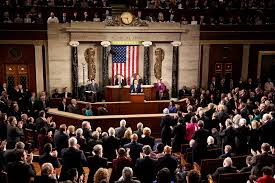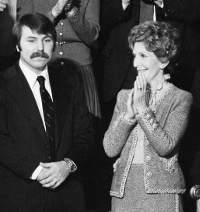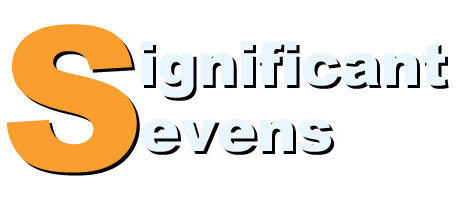The State of the Union Address: How It Works
The U.S. Constitution tasks the President, in Article II, Section 3, thus: "He shall from time to time give to Congress information of the State of the Union and recommend to their Consideration such measures as he shall judge necessary and expedient." That wording does not contain any reference to annual address, but that is the tradition has to come to be in place when a President is in office. The first President, George Washington, gave the first State of the Union address in 1790; it wasn't call that then, but it did do what the Constitution said it should. (See here for a history of the State of the Union.) 
As it stands in the modern era, the State of the Union is a televised address from the President to the American people, delivered in the House of Representatives to nearly the entire rest of the top levels of the U.S. Government. The timing of the addressed is designed to coincide with the Congress's being back in session, after the annual recess for the end-of-year holidays. This usually means late January or early February. For the address, seats are reserved for all members of the House and Senate, all of the Justices of the U.S. Supreme Court, all members of the Cabinet, all of the Joint Chiefs of Staff, and the Dean of the Diplomatic Corps. Each year, one member of the Cabinet is chosen to remain away from the address, as a safety measure in case of an attack on the House chamber during the address. Since the attacks on New York and Washington, D.C., on Sept. 11, 2001, a handful of members of Congress have accompanied this absent Cabinet member to a secure location away from the House Chambers. It's not just Government officials who are in attendance. Each members of Congress can bring along one guest. The President may invite up to 24 guests, as can the Speaker of the House. Since 1982, the President, the First Lady, and others have taken to inviting as guests members of the public to which they want to draw attention during the address, such as military heroes or people whose life stories are particularly compelling. The President gives the address while standing behind a podium in the center of the front of the House. Seated behind the President during the address are the Vice-president and the Speaker of the House. The President's address usually contains reference to how the President thinks the country–its people, its economy, its military, its etc.–are doing. Observers listen for certain words during the address, such as, "The State of the Union is strong." One strong exception to that was the first State of the Union address given by then-President John F. Kennedy. In 1961, his address, set against the backdrop of the Cold War, contained scary language like "the hour of maximum danger." The President also usually ticks off a sometimes long list of legislative priorities for Congress to consider in the time ahead. The announcement of many items in this list are greeted with applause from members of Congress and others in attendance.  The President can invite up to 24 guests to attend the State of the Union address. The inclusion of famous people or people with inspirational stories began in 1982, when then-President Ronald Reagan during his speech recognized Leny Skutnik (right, with then-First Lady Nancy Reagan), a Government Budget Office employee who had pulled a survivor from the ice-filled Potomac River after a plane crashed into the river. Nearly every President since that time has invited special guests to sit with or near the First Lady in a special area of the House chamber during the speech; the President often mentions the names of some of the special guests, often encouraging them to stand and receive a standing ovation. It is also customary for a televised response address to follow the President's State of the Union address. This response is nearly always given by a member of the political party other than that of the President. Nearly all of the major television networks in America broadcast both addresses live in their entirety. Many radio networks also broadcast the addresses. The President may, from time to time, deliver addresses to both houses of Congress; only one speech is commonly referred to as the State of the Union. |
|
Social Studies for Kids
copyright 2002–2024
David White





